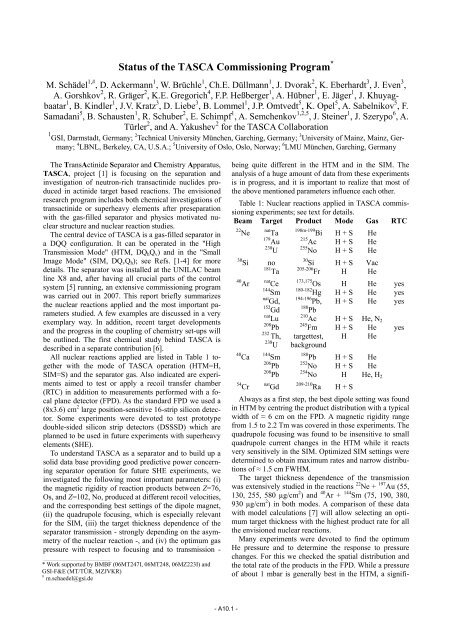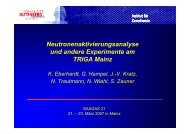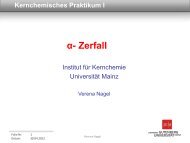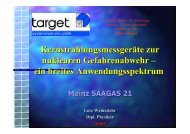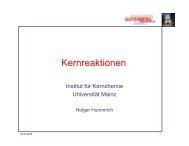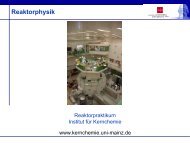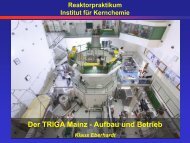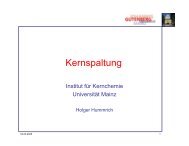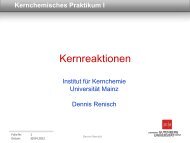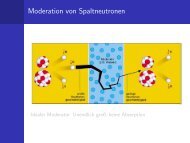jahresbericht 2007 - Institut für Kernchemie - Johannes Gutenberg ...
jahresbericht 2007 - Institut für Kernchemie - Johannes Gutenberg ...
jahresbericht 2007 - Institut für Kernchemie - Johannes Gutenberg ...
You also want an ePaper? Increase the reach of your titles
YUMPU automatically turns print PDFs into web optimized ePapers that Google loves.
Status of the TASCA Commissioning Program *<br />
M. Schädel 1,# , D. Ackermann 1 , W. Brüchle 1 , Ch.E. Düllmann 1 , J. Dvorak 2 , K. Eberhardt 3 , J. Even 3 ,<br />
A. Gorshkov 2 , R. Gräger 2 , K.E. Gregorich 4 , F.P. Heßberger 1 , A. Hübner 1 , E. Jäger 1 , J. Khuyagbaatar<br />
1 , B. Kindler 1 , J.V. Kratz 3 , D. Liebe 3 , B. Lommel 1 , J.P. Omtvedt 5 , K. Opel 5 , A. Sabelnikov 5 , F.<br />
Samadani 5 , B. Schausten 1 , R. Schuber 2 , E. Schimpf 1 , A. Semchenkov 1,2,5 , J. Steiner 1 , J. Szerypo 6 , A.<br />
Türler 2 , and A. Yakushev 2 for the TASCA Collaboration<br />
1 GSI, Darmstadt, Germany; 2 Technical University München, Garching, Germany; 3 University of Mainz, Mainz, Germany;<br />
4 LBNL, Berkeley, CA, U.S.A.; 5 University of Oslo, Oslo, Norway; 6 LMU München, Garching, Germany<br />
The TransActinide Separator and Chemistry Apparatus,<br />
TASCA, project [1] is focusing on the separation and<br />
investigation of neutron-rich transactinide nuclides produced<br />
in actinide target based reactions. The envisioned<br />
research program includes both chemical investigations of<br />
transactinide or superheavy elements after preseparation<br />
with the gas-filled separator and physics motivated nuclear<br />
structure and nuclear reaction studies.<br />
The central device of TASCA is a gas-filled separator in<br />
a DQQ configuration. It can be operated in the "High<br />
Transmission Mode" (HTM, DQ h Q v ) and in the "Small<br />
Image Mode" (SIM, DQ v Q h ); see Refs. [1-4] for more<br />
details. The separator was installed at the UNILAC beam<br />
line X8 and, after having all crucial parts of the control<br />
system [5] running, an extensive commissioning program<br />
was carried out in <strong>2007</strong>. This report briefly summarizes<br />
the nuclear reactions applied and the most important parameters<br />
studied. A few examples are discussed in a very<br />
exemplary way. In addition, recent target developments<br />
and the progress in the coupling of chemistry set-ups will<br />
be outlined. The first chemical study behind TASCA is<br />
described in a separate contribution [6].<br />
All nuclear reactions applied are listed in Table 1 together<br />
with the mode of TASCA operation (HTM=H,<br />
SIM=S) and the separator gas. Also indicated are experiments<br />
aimed to test or apply a recoil transfer chamber<br />
(RTC) in addition to measurements performed with a focal<br />
plane detector (FPD). As the standard FPD we used a<br />
(8x3.6) cm 2 large position-sensitive 16-strip silicon detector.<br />
Some experiments were devoted to test prototype<br />
double-sided silicon strip detectors (DSSSD) which are<br />
planned to be used in future experiments with superheavy<br />
elements (SHE).<br />
To understand TASCA as a separator and to build up a<br />
solid data base providing good predictive power concerning<br />
separator operation for future SHE experiments, we<br />
investigated the following most important parameters: (i)<br />
the magnetic rigidity of reaction products between Z=76,<br />
Os, and Z=102, No, produced at different recoil velocities,<br />
and the corresponding best settings of the dipole magnet,<br />
(ii) the quadrupole focusing, which is especially relevant<br />
for the SIM, (iii) the target thickness dependence of the<br />
separator transmission - strongly depending on the asymmetry<br />
of the nuclear reaction -, and (iv) the optimum gas<br />
pressure with respect to focusing and to transmission -<br />
___________________________________________<br />
* Work supported by BMBF (06MT247I, 06MT248, 06MZ223I) and<br />
GSI-F&E (MT/TÜR, MZJVKR)<br />
#<br />
m.schaedel@gsi.de<br />
being quite different in the HTM and in the SIM. The<br />
analysis of a huge amount of data from these experiments<br />
is in progress, and it is important to realize that most of<br />
the above mentioned parameters influence each other.<br />
Table 1: Nuclear reactions applied in TASCA commissioning<br />
experiments; see text for details.<br />
Beam Target Product Mode Gas RTC<br />
22 Ne<br />
nat Ta<br />
198m-199 Bi H + S He<br />
179 Au<br />
215 Ac H + S He<br />
238 U<br />
255 No H + S He<br />
30 Si no<br />
30 Si H + S Vac<br />
181 Ta<br />
205-206 Fr H He<br />
40 Ar<br />
nat Ce<br />
173,175 Os H He yes<br />
144 Sm<br />
180-182 Hg H + S He yes<br />
nat Gd,<br />
194-196 Pb, H + S He yes<br />
48 Ca<br />
54 Cr<br />
152 Gd<br />
nat Lu<br />
208 Pb<br />
232<br />
Th,<br />
238 U<br />
144 Sm<br />
206 Pb<br />
208 Pb<br />
nat Gd<br />
188 Pb<br />
210 Ac H + S He, N 2<br />
245 Fm H + S He yes<br />
targettest, H He<br />
background<br />
188 Pb H + S He<br />
252 No H + S He<br />
254 No H He, H 2<br />
209-210 Ra H + S<br />
Always as a first step, the best dipole setting was found<br />
in HTM by centring the product distribution with a typical<br />
width of ≈ 6 cm on the FPD. A magnetic rigidity range<br />
from 1.5 to 2.2 Tm was covered in those experiments. The<br />
quadrupole focusing was found to be insensitive to small<br />
quadrupole current changes in the HTM while it reacts<br />
very sensitively in the SIM. Optimized SIM settings were<br />
determined to obtain maximum rates and narrow distributions<br />
of ≈ 1.5 cm FWHM.<br />
The target thickness dependence of the transmission<br />
was extensively studied in the reactions 22 Ne + 197 Au (55,<br />
130, 255, 580 µg/cm 2 ) and 40 Ar + 144 Sm (75, 190, 380,<br />
930 µg/cm 2 ) in both modes. A comparison of these data<br />
with model calculations [7] will allow selecting an optimum<br />
target thickness with the highest product rate for all<br />
the envisioned nuclear reactions.<br />
Many experiments were devoted to find the optimum<br />
He pressure and to determine the response to pressure<br />
changes. For this we checked the spatial distribution and<br />
the total rate of the products in the FPD. While a pressure<br />
of about 1 mbar is generally best in the HTM, a signifi-<br />
- A10.1 -


